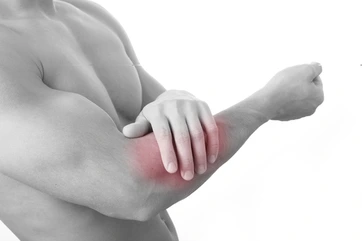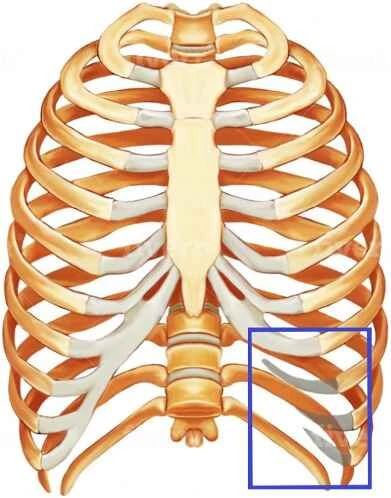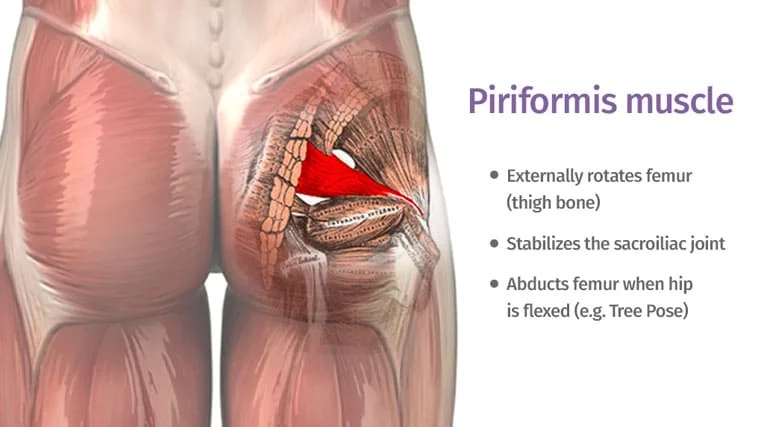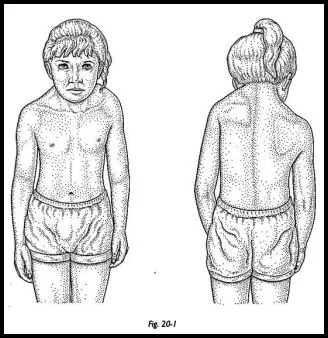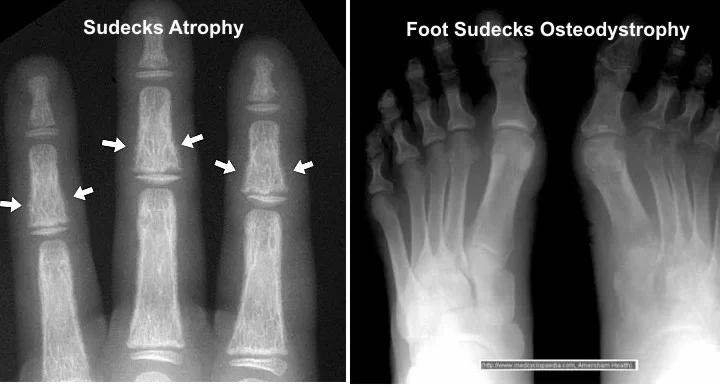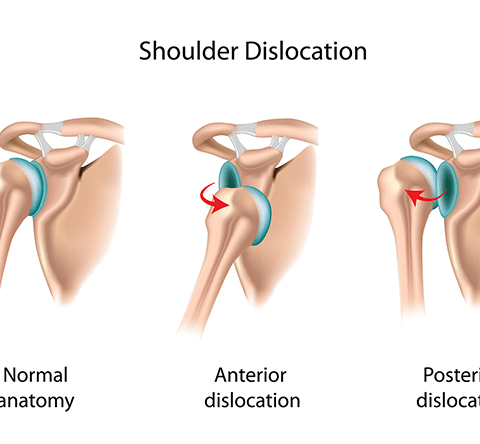Forearm Muscle Pain
Forearm muscle pain occurs when you experience pain when moving your hands and arms. The patient’s everyday life is severely disrupted by this agony. There are various causes of this pain, and each one calls for a unique strategy for therapy.
What is forearm muscle pain?
- The forearm contains numerous muscles that are responsible for hand and arm movements.
- Forearm muscle pain may result from any hand or arm injuries.
- because of an injury to the forearm muscles, which can seriously limit movement and interrupt daily activities.
- The patient has trouble gripping an object with one hand and typing on a keyboard when they have forearm pain.
- The majority of the time, rest and scheduled movement help people manage their forearm pain.
- Both exercise and electrotherapy help to alleviate this muscle soreness.
Muscles of the forearm:
Two compartments of forearm muscles:
- Anterior Compartment
- Posterior compartment
The forearm’s anterior compartment muscles:
Depending on the muscular layer, the forearm muscle’s anterior compartment is separated into three sections.
Superficial muscles:
- Flexor carpi ulnaris
- Flexor carpi radialis
- Palmaris longus
- Pronator teres
- A single tendon that emerges from the humerus bone’s medial epicondyle is the source of all muscles.
Intermediate muscle:
- Flexor digitorum superficialis.
- The medial epicondyle of the humerus bone is the origin of one of this muscle’s two heads, whereas the radius bone is the origin of the other.
Deep muscles:
- Flexor pollicis longus
- Pronator quadratus
- Flexor digitorum profundus
- Pronation of the forearm, wrist joint flexion, and finger flexion are all performed by this anterior compartment muscle group.
- The ulnar and radial arteries provide the vascular supply to this anterior compartment muscle group, which is mostly innervated by the median nerve.
The forearm’s posterior compartment muscles:
The extensor muscles are the muscles found in the forearm’s posterior compartment.
The radial nerve innervates the entire posterior compartment of the forearm muscles.
Depending on the muscular layer, the forearm muscle’s posterior compartment is separated into two sections.
Superficial Muscles:
- Extensor carpi radialis brevis
- Extensor digitorum
- Extensor carpi ulnaris
- Extensor digiti minimi
- Brachioradialis
- Extensor Carpi Radialis Longus & Brevis
Deep Muscles:
- The supinator
- Abductor pollicis longus
- Extensor pollicis brevis
- Extensor pollicis longus
- Extensor indicis.
Causes of the forearm muscle pain?
Injury:
- Acute trauma, such as a fall, can result in ligament and tendon injury as well as a fracture in one of the forearm bones.
Overuse:
- Forearm strains can result from sports like tennis and some forms of weightlifting that place a lot of force on the muscles.
- Overuse of computers can also lead to repetitive strain injury (RSI), which is a strain on the forearm muscles.
- Repetitive strain injuries, or RSIs, are becoming more prevalent in the workplace and are mostly caused by an increase in computer-based labor.
- stiffness in the forearm muscles caused by inactivity, usually following an accident.
Nerve entrapment:
- The affected area may experience pain, numbness, or a tingling sensation when the nerves are overly squeezed.
- Numerous syndromes that impact the forearm muscle might result in nerve entrapment.
Arthritis:
- The wrist and elbow joints are affected by arthritis, which causes a dull aching in the forearm muscles.
- An underlying condition: A number of illnesses, such as angina, which causes forearm pain.
- Sports injuries and inflammation in the forearm muscles are the causes of the pain.
- Infections, nerve issues, growths, and possibly cancer are linked to this forearm muscle pain.
Other circumstances that result in forearm muscle soreness include:
- Sports injuries
- Tendinitis
- Dislocation
- Overuse injury
- Bone fracture
Symptoms of the forearm muscle pain
The signs and symptoms of a forearm muscle injury vary depending on the underlying illness.
- The patient experiences forearm muscular weakness.
- Affected areas are warmth, redness, and swelling.
- Reduced mobility translates into a range of motion, or ROM, for the wrist and elbow joints.
- The patient experiences pain in all upper limbs, including the shoulder, arm, hand, and finger.
- An area of pain also exhibits tenderness.
- occasionally exhibit obvious elbow and wrist joint deformities.
- The patient experiences tingling and numbness in the arm.
- Skin discoloration, such as bruises, can occasionally develop. These symptoms could point to a serious illness.
Under what circumstances should I call a doctor right away if I have muscle pain?
- Forearm pain can occasionally coexist with other symptoms, indicating a dangerous problem that needs to be treated right away in an emergency room.
- Call 911 for treatment if you require medical attention right away.
Some severe illnesses that require prompt medical attention include:
- When the bone protrudes from the skin
- If it happens to The forearm is bleeding excessively.
- Muscle paralysis in the forearm
- If the patient experiences sudden, severe forearm pain.
Treatment for the forearm muscle pain?
When muscular pain first appears, the RICE concept is applied.
The RICE principle
- R-rest is the reduction of forearm activity, which aids in the healing of injured tendons, ligaments, muscles, bones, and nerves. Instead of staying idle for extended periods of time, a person takes occasional breaks.
- I-ice = applied to the painful area for 20 minutes, which helps to relieve pain and inflammation. To relieve the pain, you can also use frozen peas and an ice pack.
- C-compression = A person must use a splint and sling to limit movement and reduce pain when movement is extremely unpleasant.
- E-elevation = Use a pillow to raise the arm and lessen edema.
Medication for pain relief:
- In order to control your pain, your doctor will typically prescribe you NSAIDs, like Ibuprofen, and other anti-inflammatory medications.
- Diofanace gel and Volini gel are two examples of pain reliever gels and patches that you utilize.
Hot therapy:
- Additionally, you are attempting to reduce the pain by applying heat therapy to the swollen area.
- To lessen the spasm and edema, a hot pack is given to the painful location.
Physical Therapy Treatment:
The goal of physical therapy is to gradually strengthen and repair the forearm through exercises, stretches, and strengthening exercises.
Stretching for forearm muscle pain:
- Wrist extensor stretch
- Forearm flexor stretch
- Supinator stretch
- Two-arm forearm stretch
- Praying forearm stretch
Wrist extensor stretch:
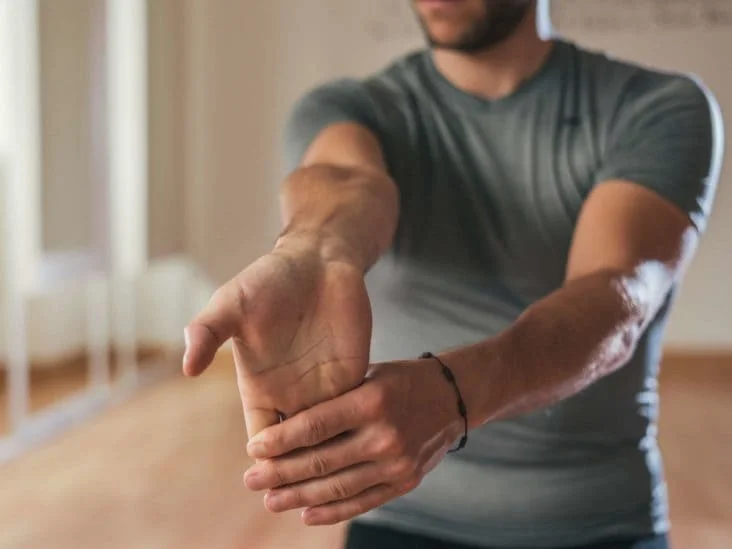
- During the stretching, the patient is either seated or standing.
- Make sure the hand is pointing down.
- The wrist joint should be bent, and the hand and forearm should feel stretched.
- To experience a further stretch, turn the arm slightly inward.
- For 20 seconds, maintain this stretching position.
Forearm flexor stretch:
- During this stretching, the patient is standing.
- With the elbow joint locked out, extend both arms in front of the body.
- Next, raise one hand’s palm in a gesture similar to a friend’s wave.
- For 15 to 30 seconds, maintain this stretching position.
Supinator stretch:
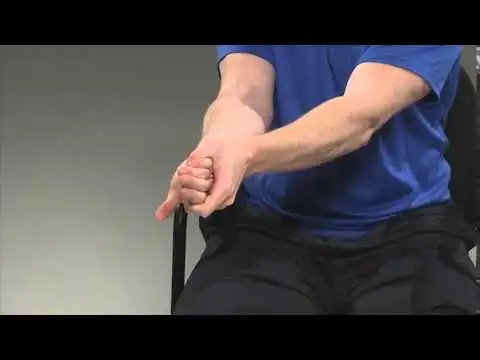
- During this stretching, the patient is seated.
- Next, place the arm on a level surface, palm down.
- For 15 to 30 seconds, maintain this stretching stance, but make sure the weight is light.
Two-arm forearm stretch:
- Then, internally rotate that is, rotate the shoulder joint medially so that the backs of the hands face one another.
- Next, Interlock all of the fingers on one hand by placing it over the other.
- Next, drive the stretched arm’s wrist joint into flexion with the non-working arm.
Praying forearm stretch:
- The patient is sitting up straight in a chair and standing.
- To get the wrist joint to bend, raise both elbow joints.
- The elbow joint should then continue to be raised until the undersides of the forearms feel nicely stretched.
Exercise for the forearm muscle pain:
You can lessen your pain by exercising.
- Elbow bend
- Wrist extension
- Elbow extension
- Wrist rotations
- Forearm squeeze
- Fingertip pushups
- Crab walk
- Plank with shoulder taps
- Isometric wall push
- Sphinx push-ups
- Pull-up bar hang
Elbow bend:
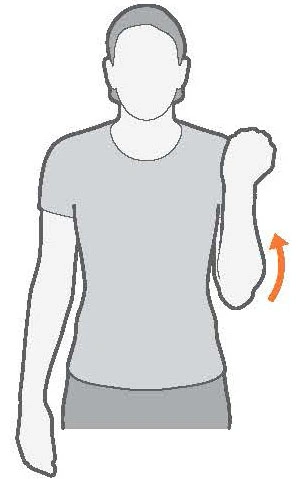
- The patient is With your arms by your sides, take a straight stance.
- Allow the inside of the hand to touch the shoulder joint while bending the right arm upward.
- Stretching only as close to the shoulder as possible is necessary if the patient is unable to reach it.
Wrist extension:
- For the wrist extension exercise, the patient is standing.
- The affected arm should then be extended such that the palm is parallel to the ground.
- Pull the wrist joint back toward the body with the other hand.
- Next, Pull the wrist joint back until the forearm muscle stretches, but do not experience any pain.
- For 30 seconds, maintain this workout stance.
Elbow extension:
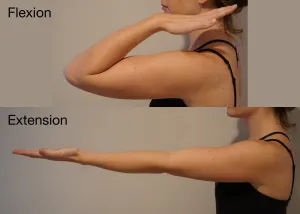
- When performing the elbow extension exercise, the patient is seated.
- Hold this position for 15 seconds when you feel a stretch but no pain.
Wrist rotations:
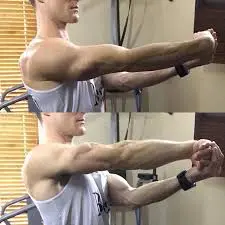
- During the wrist rotations, the patient is seated.
- The patient’s arms are extended in front of them, and their hands are at shoulder height.
- In a single session, complete ten repetitions in either direction.
Forearm squeeze:
- After three to five seconds of holding this exercise, release your grip for a short while.
- Keep doing this exercise for ten to fifteen minutes at a time.
- Perform this workout two or three times every day.
Fingertip push-ups:
- The patient is bringing their fingertips to the surface while kneeling next to a bench or other stable object.
- The patient brings their chest to the bench slowly and carefully, then bends their elbow joint to a 90-degree angle.
- Perform this exercise in two to three sets of eight to twelve reps.
Crab walk:
- The patient is reversing the tabletop position.
- Directly place the ankle joint beneath the knee joint.
Plank with shoulder taps:
- As in a push-up, place the hands squarely beneath the shoulder joint.
- Surely Keep your core muscles steady.
- Raise your right hand off the floor and place it on the shoulder on the other side.
- Spend 30 to 60 seconds on this exercise, or as long as the patient is able.
- Do this exercise two or three times.
Isometric wall push:
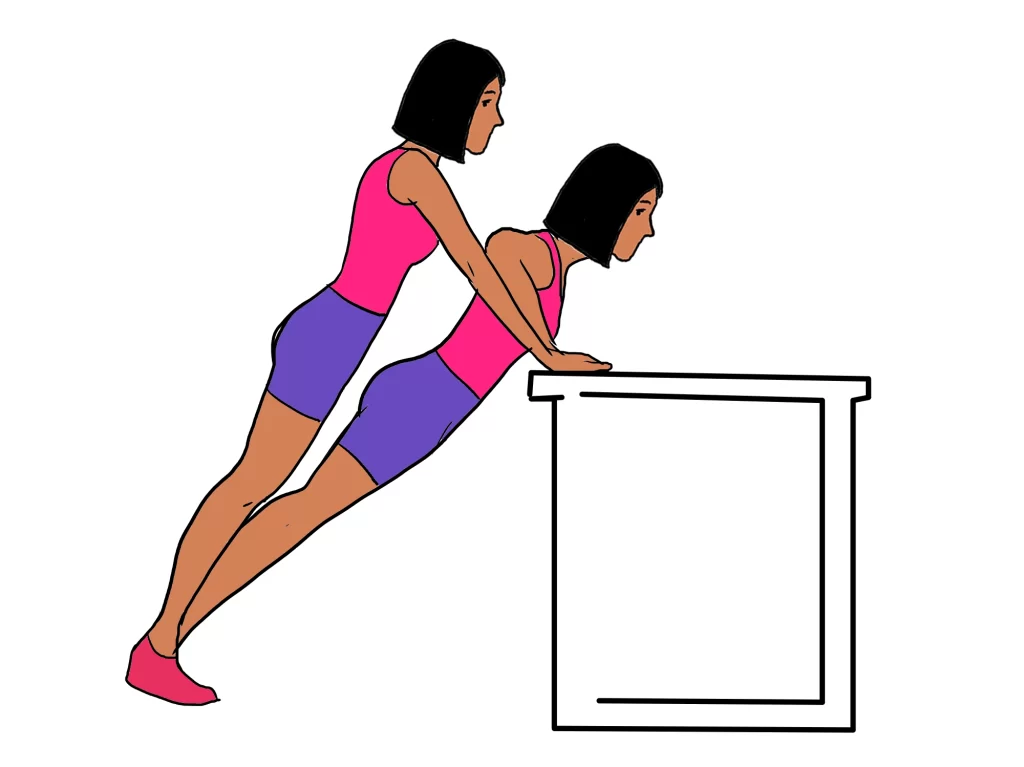
- Maintaining a straight arm position without locking the elbow joint.
- Release the pressure after 30 seconds.
- Do this workout two or three times a day.
Sphinx push-ups:
- The patient begins by performing a forearm plank on both the knees and the toes.
- After that, firmly press your hands down and attempt to raise your forearms till they are straight.
- Take it one inch and two at a time if you are unable to go all the way at first.
- Let go of the pressure.
- Do this workout two or three times a day.
Pull-up bar hang:
- Initially With your palms facing front and your hands shoulder-distance apart, grasp the pull-up bar.
- Keep your arms straight and your ankles crossed behind you as you hang for up to 30 seconds.
- Let go.
- Do this workout two or three times a day.
- Next, Make this activity more difficult: Grasp the bar with two tiny towels wrapped around it.
Strengthening exercise the forearm muscle pain:
This forearm strengthening exercise helps you build stronger forearm muscles and lessen forearm weakness.
- Palms-up wrist curl
- Palms-down wrist curl
- Grip crush
- Wrist dumbbell curls
- Farmer’s walks
- Pinch-grip plate holds
- Reverse barbell curl with the thumb-less grip
Palms-up wrist curl:
- With the hands facing up, place the wrist joint on the knee joint and a level surface while seated.
- In each hand, the patient is gripping a dumbbell.
- Then, without moving the arms, elevate the hands as high as you can. However, if the wrist joint doesn’t lift off the ground, it is in a resting posture.
Palms-down wrist curl:
- With the hands facing up, place the wrist joint on the knee joint and a level surface while seated.
- The patient is required to hold a dumbbell in each hand, raise it as high as they can, and maintain a motionless arm position.
- However, the wrist joint is at rest if it does not rise off the surface.
- Return the hands to their initial posture after a brief delay.
Grip crush:
- The patient uses a holding dumbbell while sitting and rests the left wrist joint on the knee and a level surface.
- Repeat on the other side after completing the ten repetitions.
Wrist dumbbell curls:
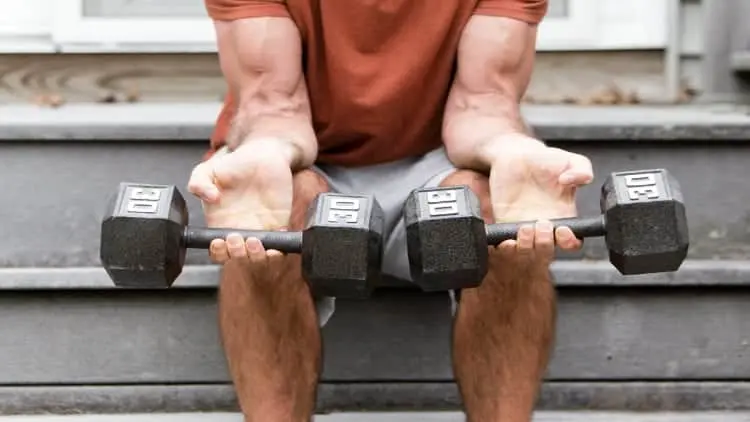
- The patient holds a relatively heavy dumbbell in each hand while seated on a bench and chair.
- Next, position the wrists above the knees by placing the forearms on the thighs.
- The palms are pointing down and up.
- Reduce the weights as gradually as the patient is able.
- Next, Hold the weights firmly and just use your hands to move them.
- To finish the muscles, repeat this exercise three times for a total of twelve repetitions.
- Another option is to work on one side at a time.
Farmer’s walks:
- The patient is tall, standing, and carrying two heavy dumbbells and a kettlebell at each side.
- Next, take a leisurely stroll from one end of the exercise area to the other and return.
- The goal of this workout is to complete one set of the Farmer’s Walk for 30 to 45 seconds.
- Next, complete the remaining tasks.
- Do this workout two or three times a day.
Pinch-grip plate holds:
- Pinch and hold a somewhat heavy plate between the thumb and the hand’s four fingers using the straight fingers.
- One side at a time, however, is how this exercise is done.
- As long as the patient is able, hold this position for 30 to 45 seconds every set.
- Next, complete the remaining tasks.
- Do this workout two or three times a day.
Reverse barbell curl with the thumb-less grip:
- The patient is standing and carrying a barbell with their hands shoulder-distance apart and palms facing down. For a “thumbless grip,” keep the thumb next to the other fingers.
- Bring the barbell steadily toward the shoulders while maintaining the elbow joint near the sides.
- Next, concentrate on your forearms by bending solely at the elbow joint.
- Go back to the beginning and proceed too slowly the entire time.
- Next, Try to complete the three sets of twelve reps.
What is a home treatment for forearm pain?
- Forearm resting typically aids in lowering the severity of edema and inflammation.
- used to ice the affected area for 10 to 15 minutes at a period using an ice pack covered in cotton, which also aids in reducing swelling.
- Using over-the-counter painkillers, such as acetaminophen (Tylenol) or ibuprofen (Advil), can help lessen pain and discomfort.
- Apply a bandage and splint to help with healing and to limit movement.
Prevention of the forearm muscle pain?
- Keep away from activities like tennis and other forms of weightlifting that impose undue strain on the forearm.
- utilizing an ergonomic keyboard at work and taking regular breaks from prolonged computer use.
- Perform forearm strengthening exercises and use resistance training to increase your grip strength.
Summary:
- If someone gets a minor strain or sprain, they might be able to use home remedies to treat it. If the symptoms worsen rather than get better, rest the forearm and consult a physician.
- The cause of the forearm pain can be determined by a physician. The majority of patients may effectively manage their symptoms without surgery because of the several treatments available for this illness.
- Call for immediate medical assistance if someone experiences sudden, severe arm pain or other symptoms that raise concerns. Treatment can alleviate forearm pain caused by a severe accident or medical emergency and lessen sequelae.
FAQs
What condition results in soreness in the forearms?
Tendinitis: Inflammation of the tendons in the forearms, which connect muscles to bones, can result in stiffness in the morning, pain at night, and tenderness that gets worse with exercise. 15. Depending on the reason, tendinitis may go by several names, such as golfer’s elbow or tennis elbow.
Which is best for pain in the forearm?
Causes, Symptoms, and Treatments of Forearm Pain
Swelling may also be lessened by applying a cloth-covered ice pack to the affected area for five minutes at a time, multiple times throughout the day. Pain can be lessened by using an over-the-counter pain reliever, such as acetaminophen (Tylenol) or ibuprofen (Advil).
What unique test is used to diagnose forearm pain?
Physical examination: Against opposition, your doctor will instruct you to turn your palm from palm down to palm up. You must maintain your middle finger straight against resistance in the second section of this test.
How can I improve the feeling in my forearm?
Extension of the wrist
The forearm muscles can be stretched using this exercise: With the palm parallel to the floor, stretch the injured arm in front of you while standing erect. Without experiencing any pain, pull the wrist back until you feel a stretch in your forearm.
Who should I see if I have forearm pain?
Orthopedic intervention may be necessary to address the cause of your arm pain, particularly if you have abnormalities, shattered bones, or nerve pain.
Can forearm pain be caused by elevated blood pressure?
It might happen when you’re at rest or when you’re exerting yourself. Sweating, nausea, radiating pain in your arm or jaw, and abrupt, crushing chest pain could all be signs of a heart attack or hypertensive crisis if you have extremely high blood pressure. Dial 911 right away.
Which exercises result in soreness in the forearm?
Because of the repetitious nature of the exercise and the considerable strain it puts on the forearm muscles and tendons, forearm pain is a typical overuse ailment linked to bicep curls. Your forearm muscles, especially the flexors, are used to stabilize your wrist and hold the weight when performing bicep curls.
Is heart disease a factor in forearm pain?
Back, shoulder, or arm pain that improves with rest and happens with any activity. This could indicate decreased blood supply to your heart muscle or cardiac disease.
Why is my forearm muscle hurting?
Forearm pain is typically caused by repetitive tension from activities like typing, tennis, and golf. These forearm pain symptoms may be caused by: stretched or pulled muscles. rips or ruptures in the muscles.
How can forearm pain be relieved?
Swelling may also be lessened by applying a cloth-covered ice pack to the affected area for five minutes at a time, multiple times throughout the day. Pain can be lessened by using an over-the-counter pain reliever, such as acetaminophen (Tylenol) or ibuprofen (Advil).
How much time may pain in the forearm last?
After receiving primary treatment for two to three weeks, the inflammation should subside. In cases of severe or chronic tendinitis, the forearm frequently needs to be totally rested for a few days. You will also need to refrain from activities that aggravate the tendon for a few weeks or months.
Can heart problems cause forearm pain?
A heart attack may even be the cause of arm pain, especially if it extends into the left arm.
Is soreness in the forearm typical?
Numerous factors can contribute to forearm pain. These include acute trauma, chronic strains, and underlying illnesses that harm bones, joints, or nerves. Forearm pain is frequently temporary and goes away on its own.
How can forearm pain be relieved?
RICE treatment: Pain and inflammation in the affected forearm muscles and tendons can be reduced with rest, ice, compression, and elevation therapy. Painkillers: Forearm pain symptoms may be reduced by over-the-counter drugs.
References
- Ladva, V. (2022b, April 7). Forearm muscle pain: Cause, Symptoms, Treatment, Exercises Samarpan. Samarpan Physiotherapy Clinic. https://samarpanphysioclinic.com/forearm-muscle-pain/
- Sankhla, D. (2023, April 27). Forearm Pain – Cause, Symptom, Treatment, Exercise- Samarpan. Samarpan Physiotherapy Clinic. https://samarpanphysioclinic.com/forearm-pain/

